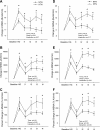Exaggerated sympathetic and pressor responses to handgrip exercise in older hypertensive humans: role of the muscle metaboreflex
- PMID: 20802135
- PMCID: PMC2993192
- DOI: 10.1152/ajpheart.00556.2010
Exaggerated sympathetic and pressor responses to handgrip exercise in older hypertensive humans: role of the muscle metaboreflex
Abstract
Recent animal studies have reported that exercise pressor reflex (EPR)-mediated increases in blood pressure are exaggerated in hypertensive (HTN) rodents. Whether these findings can be extended to human hypertension remains unclear. Mean arterial pressure (MAP), muscle sympathetic nerve activity (MSNA), and venous metabolites were measured in normotensive (NTN; n = 23; 60 ± 1 yr) and HTN (n = 15; 63 ± 1 yr) subjects at baseline, and during static handgrip at 30 and 40% maximal voluntary contraction (MVC) followed by a period of postexercise ischemia (PEI) to isolate the metabolic component of the EPR. Changes in MAP from baseline were augmented in HTN subjects during both 30 and 40% MVC handgrip (P < 0.05 for both), and these group differences were maintained during PEI (30% PEI trial: Δ15 ± 2 NTN vs. Δ19 ± 2 HTN mmHg; 40% PEI trial: Δ16 ± 1 NTN vs. Δ23 ± 2 HTN mmHg; P < 0.05 for both). Similarly, in HTN subjects, MSNA burst frequency was greater during 30 and 40% MVC handgrip (P < 0.05 for both), and these differences were maintained during PEI [30% PEI trial: 35 ± 2 (NTN) vs. 44 ± 2 (HTN) bursts/min; 40% PEI trial: 36 ± 2 (NTN) vs. 48 ± 2 (HTN) bursts/min; P < 0.05 for both]. No group differences in metabolites were observed. MAP and MSNA responses to a cold pressor test were not different between groups, suggesting no group differences in generalized sympathetic responsiveness. In summary, compared with NTN subjects, HTN adults exhibit exaggerated sympathetic and pressor responses to handgrip exercise that are maintained during PEI, indicating that activation of the metabolic component of the EPR is augmented in older HTN humans.
Figures




Comment in
-
Exercise in hypertension: do skeletal muscle reflexes make this a dangerous proposition?Am J Physiol Heart Circ Physiol. 2010 Nov;299(5):H1302-3. doi: 10.1152/ajpheart.00896.2010. Epub 2010 Sep 17. Am J Physiol Heart Circ Physiol. 2010. PMID: 20852038 No abstract available.
References
-
- Anderson EA, Sinkey CA, Lawton WJ, Mark AL. Elevated sympathetic nerve activity in borderline hypertensive humans. Evidence from direct intraneural recordings. Hypertension 14: 177–183, 1989 - PubMed
-
- Aoki K, Sato K, Kondo S, Pyon CB, Yamamoto M. Increased response of blood pressure to rest and handgrip in subjects with essential hypertension. Jpn Circ J 47: 802–809, 1983 - PubMed
-
- Borg GA. Psychophysical bases of perceived exertion. Med Sci Sports Exerc 14: 377–381, 1982 - PubMed
-
- Chirinos JA, Segers P, Raina A, Saif H, Swillens A, Gupta AK, Townsend R, Emmi AG, Jr, Kirkpatrick JN, Keane MG, Ferrari VA, Wiegers SE, St. John Sutton MG. Arterial pulsatile hemodynamic load induced by isometric exercise strongly predicts left ventricular mass in hypertension. Am J Physiol Heart Circ Physiol 298: H320–H330, 2010 - PubMed
Publication types
MeSH terms
Grants and funding
LinkOut - more resources
Full Text Sources
Medical
Research Materials

